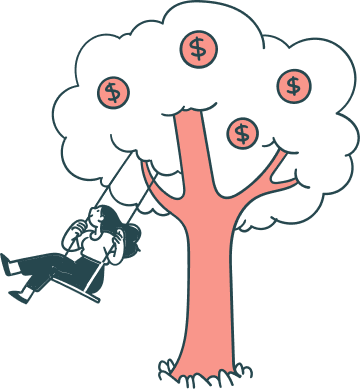In recent years, nonprofits have had to learn to be increasingly innovative with their fundraising techniques, and that trend isn’t going away. To keep up with donors, organizations must create fundraising campaigns that blend traditional and digital elements. One effective way to do this is to use peer-to-peer fundraising.
Peer-to-peer fundraising has been used by nonprofits for years with great success, but this type of campaign is only increasing in popularity as nonprofits focus more on hybrid fundraising strategies.
As experts in online fundraising, we’re here to give you all the information and tools you need to create your own successful peer-to-peer campaign. In this guide, we’ll cover everything your nonprofit needs to know:
- What is peer-to-peer fundraising?
- How peer-to-peer fundraising works
- Peer-to-peer fundraising FAQ
- Peer-to-peer fundraising vs. Crowdfunding
- Peer-to-peer fundraising tips
- Top 5 peer-to-peer fundraising ideas
- Considerations when choosing a peer-to-peer platform
- Top peer-to-peer fundraising platforms to choose from
Peer-to-peer campaigns can work well for any nonprofit, including yours. Let’s go through the basics so you can get started creating your own campaign!

What is peer-to-peer fundraising?
Peer-to-peer fundraising is a type of fundraising where a nonprofit’s supporters take the lead by raising money on behalf of the organization. Each supporter who volunteers to participate creates their own campaign page, then they reach out to their own social networks to ask for donations.
This method works so well because of the idea of social proof. Essentially, when someone sees a friend promoting your organization, they’re more likely to trust your mission and donate themselves.
In fact, a survey by YouGov found that “almost four in 10 (39%) Americans say they’ve donated to a charity because of a request from a family member or friend.” Instead of receiving just one donation from a supporter in a standard campaign, you can end up with a whole family’s contribution through peer-to-peer fundraising.
With each of your volunteer fundraisers publicizing their support, your nonprofit receives access to entire new networks of potential donors.

How peer-to-peer fundraising works
Your supporters take the lead in peer-to-peer campaigns, but your organization sets the structure and provides guidance. We’ve broken the peer-to-peer fundraising process down into seven key steps:
- Set a peer-to-peer fundraising goal. Just like any other fundraising campaign, you want to start by setting a goal. What does your organization need from this fundraiser? How much do you hope to raise?
- Select a platform for your campaign. This is the online platform that will host all your volunteers’ campaign pages, so choosing the right platform is an important decision. We’ll go into more detail later in this article about the different software available and the benefits of each.
- Ask supporters to design their fundraising pages. Each volunteer will direct their friends and family to their individual fundraising page. The more personalized these are, the better. Ask volunteers to add photos and biographies about their history with the organization. They can also personalize their appeals for donations to explain why they’re supporting your cause (and why their friends should, too).
- Supporters share that fundraising page with friends and family. Peer-to-peer fundraising tools make it easy for supporters to share their pages on social media. Look for software with social sharing buttons to make this process even simpler for your fundraisers. Of course, they’ll also use email, word of mouth, and any other way they can reach their personal networks.
- Friends and family of fundraisers donate to the campaign page. Here’s where the donations come in! As donations start adding up from each individual campaign, keep your supporters updated on the overall campaign progress. Keep the momentum going right to the end.
- Optional—wrap up the campaign with an event. If you want to celebrate your peer-to-peer campaign and the volunteers who made it happen, you can host a fun wrap-up event. This can work well either in-person or online.
- Follow up and say thank you! Don’t forget this important step. Your supporters made this campaign work, so show them your appreciation! Follow up to thank both those who raised money on your behalf as well as those who donated to the campaign. They were both integral to your campaign’s success.
Now that you know what peer-to-peer fundraising is and how it works, let’s go over any remaining questions you may have.

Peer-to-peer fundraising FAQ
What are the benefits of peer-to-peer fundraising?
Aside from the great potential to raise money as a part of your campaign, the greatest benefit of peer-to-peer fundraising is access to a wider network of potential donors. Through this extended network, your supporters spread the word about your organization’s mission. Your nonprofit benefits from increased awareness, and you acquire new first-time donors who may become lifetime supporters.
The other major benefit for your organization is engagement with your existing supporters. Often, donors who are passionate about your mission want to be more involved, and peer-to-peer fundraising gives them a great opportunity to do so. Make being a volunteer fundraiser an enriching experience for them, and they’ll want to give their support even more in the future.
What are the different types of peer-to-peer fundraisers?
The simple structure of peer-to-peer fundraisers offers plenty of room for flexibility. They can be completely virtual, a mix of in-person and online elements, or structured around a major event. You can make your campaign into a friendly competition with teams of volunteers or run everything on an individual level. It all depends on what you determine to be best for your nonprofit.
Most variations of peer-to-peer fundraising fall into two main categories:
- Rolling campaigns are a year-round opportunity for supporters to set up a campaign whenever fits their schedule. For example, someone may ask friends to donate to your organization around their birthday.
- Time-based campaigns follow a schedule that you set and have a predetermined end date. These can be focused on a specific theme, event, or project. With time-based campaigns, keeping volunteers engaged with progress updates and encouragement is especially important.
To decide which type of campaign will work best for you, think about your organization’s goals and budget. Consider the size of your support base and their preferences, too.
How do you retain donors after your peer-to-peer fundraiser?
It can be a challenge to retain new donors if they only donated because a friend asked them to. You can combat this by being intentional and proactive.
Before the campaign starts, reevaluate how you thank donors. Make sure that you send out immediate, personal thank you’s to each and every donor. Include information about your mission and ways they can get involved. Then, thank them again at the end of the campaign, and show them tangibly how they’ve made an impact.
What kinds of organizations benefit from peer-to-peer fundraisers?
It’s not just for large nonprofits! With the right tools, resources, and planning, any organization can run an effective peer-to-peer fundraising campaign. This includes small nonprofits, churches, schools, and other community organizations.
Make use of peer-to-peer fundraising’s flexibility and tailor the campaign to meet your needs. Always keep your audience in mind, and use the results of previous fundraisers you’ve run to inform your decisions.

Peer-to-peer fundraising vs. Crowdfunding
Both peer-to-peer fundraising and crowdfunding enable your supporters to help your organization raise money, so what’s the difference?
In a crowdfunding campaign, your supporters are less directly involved in the fundraising process. Crowdfunding involves:
- Only one main donation page
- Supporters share that same campaign page with friends and family
- A crowdfunding platform
- No volunteer fundraisers
Peer-to-peer fundraisers, on the other hand, empower individual supporters to be the focal point of the campaign. Peer-to-peer fundraising involves:
- A personal campaign page for each volunteer
- Supporters share their own donation pages
- A dedicated peer-to-peer fundraising platform
- Individual goals in addition to overall goals
Crowdfunding is a great way to fundraise online and continues to grow in popularity. But if you want to raise money and build stronger relationships with your supporters at the same time, peer-to-peer fundraising is the best choice.

Peer-to-peer fundraising tips
To run effective fundraisers, you should constantly try to improve your campaigns. Base decisions on your own past fundraising wins and challenges, and use data whenever possible. Here are some general tips you can use to improve your campaign and get the most out of peer-to-peer fundraising:
Gamify your fundraiser
To keep up your volunteers’ spirits, make the fundraising process fun! Peer-to-peer fundraising platforms offer several easy ways to gamify your campaign.
Use fundraising thermometers to create a visual representation of the progress you’ve made towards your goal. Supporters can check back often to see how much the “temperature” has risen and to easily see how much more money they need to raise to reach the goal. As you get closer to the end of a time-based campaign, thermometers also create a sense of urgency for the final fundraising push.
Another way to add a fun element is to encourage a little friendly competition with leaderboards. Supporters can check the leaderboards to see which volunteer fundraisers have raised the most money at any given point in the campaign. You can also use your nonprofit’s social media accounts to shout out and tag top fundraisers.
Choose an intuitive software platform
Using a fundraising platform that’s easy to navigate makes it much easier for supporters to get involved. Choose a platform that allows each supporter to design and personalize their donation page with drag and drop or other simple customization features.
With intuitive software, you can make sure all of your supporters’ fundraising pages are well-designed, personal, and compelling. Be sure to check out our selection of top peer-to-peer fundraising platforms to choose from at the bottom of this page.
Check in with your fundraisers often
Make sure you’re giving volunteers enough support throughout the entire campaign, not just in the beginning. Here are some best practices for supporting your fundraisers:
- Provide fundraising page guidance. Show them step-by-step how to create a fundraising page, and suggest ways they can personalize them. Give examples, and let them know where they can find technical help if they need it.
- Coach them on how to get the most out of their fundraising efforts. Show supporters how to create social media posts to engage their followers, and encourage them to share posts from your organization’s main account.
- Send out periodic updates. Post on social media, and email supporters progress updates from the fundraising thermometer and the leaderboard. You can do this weekly or whenever donations reach a key milestone.
- Be available for any help they need. Give supporters a specific email address they can reach out to so they can contact your organization. Emphasize that they can ask for help or advice at any time.
And of course, thank your volunteer fundraisers often! Don’t wait until the end of the campaign to let them know how much you appreciate and value them.
Tie the campaign to an event
A 5K or bike-a-thon is the perfect way to make the most of your peer-to-peer fundraiser. Running your campaign around an event gives your supporters added motivation to raise money. It’s also an opportunity to build community, especially if you can hold the event in-person. Learn more about event ideas in the next section.

Top 5 peer-to-peer fundraising ideas
This type of fundraising offers so much room for creativity! We’ll review five of our favorite ideas that you can use as part of your peer-to-peer fundraising plan.
1. 5K Race
Who doesn’t love an opportunity to raise money for a good cause and stay active at the same time? 5K races tend to be extremely popular fundraisers, and they’re very easy to pair with peer-to-peer techniques. When participants ask friends to donate to their campaign pages, they can also ask them to attend or participate in the race. You can sell t-shirts or branded water bottles at the event for even more fundraising potential.
2. “Thon” – Style Events
For “thon” events, participants use their campaign pages to collect pledges for donations before they complete an activity, such as walking or biking. For example, in a walk-a-thon, donors would pledge to give a certain amount for each mile walked. Then, your volunteer collects donations based on how far they ended up walking. Other “thon” events you can do include:
- Bike-a-thons
- Dance-a-thons
- Bake-a-thons
Survey your supporters ahead of time to see what kind of activity they’d like to do best. You’re not limited to these options—you can make almost any activity into a “thon”!
3. Gala
Galas are always a fun way to gather supporters together and raise money. Add a peer-to-peer element to this classic fundraising event by having your volunteers sell tickets to the gala in exchange for a certain donation amount. You can even recognize top fundraisers at the gala itself.
4. Matching Gift Drive
Add matching gifts to your peer-to-peer campaign to maximize campaign success. Many of your supporters likely work for companies that offer to match employee donations at a certain rate, but they may not even know it. Adding a matching gift drive element to your campaign is a great way to raise awareness of this opportunity (and funds!). Donors will be able to see if they’re match eligible, and if they are, their donation will get matched!
5. Viral Video Challenge
TikTok challenges continue to rise in popularity, so why not use one to raise money for your organization? Create a video challenge for your supporters to do, then tell them to tag friends in their videos to challenge them next.
Each person who completes the challenge should donate a small amount to your nonprofit, and those who refuse the challenge should donate even more. This is a twist on traditional peer-to-peer fundraising that can be a lot of fun for your supporters.

Considerations when choosing a peer-to-peer platform
Once you have a plan for the kind of campaign you want to run, it’s time to start looking into peer-to-peer fundraising platforms. We’ll go over our suggestions for platforms in the next section, but here are the factors you should look for when making your decision:
- Intuitive navigation. You want to make creating a campaign page as easy for supporters as possible. The less time they have to spend solving technical difficulties, the more time they can spend fundraising.
- Customization options. Look for software that allows supporters to add their own images and text to personalize their fundraising pages.
- Sharing buttons. Volunteers should be able to easily share their pages on social media to reach more of their friends.
- Gamification features. Fundraising thermometers and leaderboards serve as motivators for your volunteers, and they make the campaign more fun!
- Mobile-optimization. Since donation pages will be shared most often over social media, they need to function properly on mobile devices. Make sure you choose a platform that makes all of your pages look right and function properly on mobile.
- Easy campaign reporting. Great peer-to-peer fundraising platforms give you access to lots of data! This is important for reaching out to say thank you to your donors as well as planning future fundraisers, marketing, and tracking the demographics of your donors. You can’t get access to this data from platforms like Facebook donation tools.
With all of these tools and features, you’ll have everything you need to create a successful fundraiser.
Top peer-to-peer fundraising platforms to choose from
We recommend these top eight peer-to-peer fundraising platforms for the best results. Let’s take a look at the top three here.

Snowball Fundraising
Our peer-to-peer fundraising platform offers unlimited campaigns and complete customization for your campaign pages. Collect donations securely online, and use our gamification features to keep supporters motivated.
With Snowball, you’ll gain access to both a peer-to-peer platform and a full suite of fundraising resources. You can use our platform to track supporter information, create segmented donor lists, and generate reports for all your important fundraising data. Leverage built-in tools like Text-to-Give to promote your campaign using unlimited trigger words and ticket sales to invite supporters to attend your peer-to-peer event.
Our platform is effective for any size organization. And best of all, we’re constantly creating new features aimed to give you the best fundraising experience possible.

OneCause
OneCause’s peer-to-peer software is a good choice for enterprise-level nonprofits or any organization basing their campaign around an auction. They offer a wide range of social media tools geared towards supporter engagement, and their platform includes customized options for different campaign types.

Bonfire
Bonfire is a product fundraising provider that specializes in t-shirt fundraising, and they include peer-to-peer options as part of their platform. Try Bonfire’s platform if you’re interested in collecting donations in exchange for branded merchandise. You can create a t-shirt design using Bonfire’s tools, then create a peer-to-peer campaign to sell those t-shirts to new supporters.
Recapping what you’ve learned
In this guide, we’ve covered everything from what peer-to-peer fundraising is to the myriad of different ways you can tailor your campaign for your nonprofit’s needs. You know the steps to run a campaign effectively, the best ways to support your volunteers, and how to evaluate different platforms to determine which is the best for you.
Peer-to-peer fundraising is a valuable opportunity to acquire new donors and empower your existing supporters at the same time. You now have the knowledge and resources you need to create a well-run campaign with fantastic results.
For even more tips on making your fundraiser as successful as it can be, check out these additional resources:
- 7 Donation Page Tips to Raise More for Your Nonprofit. Use this guide to improve your main campaign page. You can also share it with your volunteer fundraisers when they create their pages.
- Fundraising Thermometer Best Practices + Free Template! Learn more about fundraising thermometers and why they work well for peer-to-peer campaigns.
- Nonprofit Donation Processing: Full Guide + 7 Top Providers. Read our full guide to processing donations easily and securely.

Ready to launch your most successful fundraiser yet?
Partner with Snowball to take your peer-to-peer fundraising to the next level.





